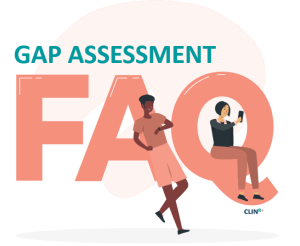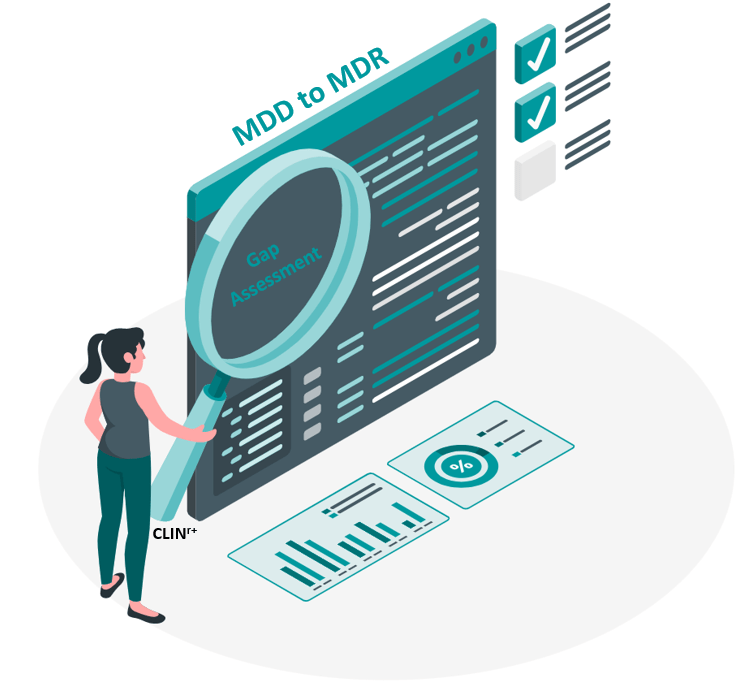Gap Assessment FAQ

Q: What is an MDR gap assessment?
A: An MDR gap assessment, also known as gap analysis, is a systematic review and comparison against regulatory requirements of a medical device’s technical file, individual documents or QMS processes to determine its compliance with the European Medical Device Regulation (EU MDR). This assessment helps identify areas of gaps (non-conformances) in the device’s documentation that could lead to CE mark being withheld or audit finding from the regulator.
Q: Why is an MDR gap assessment important?
A: Gap assessments are used at the start of a regulatory transition and before the submission of your Technical Documentation. The assessment highlights what is missing for compliance and guides manufacturers in allocating necessary resources to close them out.
An MDR gap assessment is crucial as it can serve as the first step in transferring from one regulation (MDD, 510K or PMA) to MDR. It and also be used as the final cross-check before submitting Technical Documentation (TD) or sections of documents to the Notified Body (NB – EU Auditors) for your EU MDR assessment. Attempts to pass your EU MDR assessment are limited to three rounds of assessment, meaning a NB will only review your documents until a certain number of non-conformances (NC) are found and will issue a non-conformance report (NCR) for you to address these gaps before they start your next round.
The implication is that if you get to your last round and the NB has not managed to review all the Technical Documentation because of all the non-conformances, they will not send your device Technical Documentation for CE certification. This can leave your device in the proverbial ‘no-man’s land’ and places your EU market strategy at risk.
Q: What does the gap assessment process involve?
A: The gap assessment process involves a thorough evaluation of a device’s technical documentation and supporting QMS processes, comparing it against the requirements outlined in the MDR. This process identifies areas of non-compliance and helps manufacturers understand what modifications are needed for compliance.
Q: How does a gap assessment benefit manufacturers?
A: Gap assessments provide manufacturers with a clear understanding of the discrepancies between their current documentation and MDR requirements. This knowledge assists in determining resource allocation, addressing non-compliance issues, and structuring compliant technical documentation.
Q: What does a gap assessment reveal?
A: Gap assessments reveal areas of non-compliance in various aspects of the device’s documentation and processes that could compromise your CE assessment process. Common gaps include issues with classification, General Safety and Performance Requirements (GSPR) compliance, labelling, Instructions for Use (IFU), clinical data, risk management, post-market surveillance, and more.
Q: Can a gap assessment help with MDD to MDR transitions?
A: Yes, it is considered ‘best-practice’ and a first step in MDD, but also other regulatory transitions. It assures the manufacturer does not duplicate efforts, as it highlights changes needed to overlapping documents to align with updated requirements, such as the overlap of the MDD Essential Requirements with MDR General Safety and Performance Requirements.
Historically gap assessments have been mostly spoken of in terms of transitioning legacy devices from the Medical Device Directive (MDD) to the MDR but can be used to transfer a device from any international regulatory jurisdiction. It is also helpful in new devices, from an academic technology transfer or start-up, as it helps highlight validation work that can be repurposed towards your EU MDR validations.
Q: How should manufacturers address the gaps identified in the assessment?
A: The gaps identified in the assessment are meant to guide manufacturers toward achieving compliance, not just to create additional work. As a manufacturer receives a list of areas to amend and what is expected, it aids the creation of a transition plan to systematically address these gaps. This also provides evidence that your QMS is working as it demonstrates continuous improvement. Outsourcing specific elements of the assessment or plans to your clinical regulatory partner is also a viable option if in-house resources are limited or you need to fast track progress.
Q: Who should complete a gap assessment?
A: Outsourcing the execution of a gap assessment to a clinical regulatory consultancy is highly recommended. External experts provide an impartial and regulatory expert view, ensuring a systematic and thorough assessment. This approach minimises disruption to internal teams’ daily operations and provides you with the latest industry insights on successful strategies to overcome gaps quickly and efficiently.
Q: How does an MDR gap assessment help manufacturers?
An MDR gap assessment provides specific insight and solutions to achieve conformity. This makes it helpful for manufacturers to prioritise and determine resource allocation needed to achieve compliance. It also guides manufacturers in structuring their technical documentation according to EU MDR standards.
Q: What devices should manufacturers prioritise for gap assessments?
A: All devices that are:
- New devices.
- Devices that need to transition to EU MDR or transition to another regulatory jurisdiction.
- Devices where the TD and QMS are ready to submit for EU MDR assessment.
- Manufacturers with MDD certified devices that need to:
- Secure a notified body for EU MDR.
- Obtain their EU MDD extension.
- Address non-conformance reports from their NB (especially related to Article 120 non-conformances).
- Make changes to the device under MDD or under MDR transition.
Manufacturers should prioritise devices based on factors such as device classification, the potential impact on CE marking, and the recency of audits. This ensures that resources are allocated efficiently to devices with the greatest compliance significance. Devices with a higher impact on CE marking, such as those with significant revenue or market presence, should be given priority in the assessment process. Ensuring their compliance is crucial for maintaining market access.
Q: How does audit history benefit the assessment process?
A: Maintaining a transparent track record with past audits is advantageous. Concealing previous issues can complicate the assessment process. Full disclosure allows for a comprehensive evaluation, leading to more accurate gap identification. Attempting to hide past compliance issues can hinder the assessment process. Transparency regarding previous challenges allows for a more accurate evaluation of current gaps and facilitates a targeted approach to achieving compliance.
Q: How do changes in the device impact the assessment?
A: Changes in the device can affect its compliance status especially if you are still under MDD (hence under the Article 120 rules for your MDD extension). Under Article 120 significant changes to the device is not allowed unless there is a safety concern. Making significant changes without your notified body review and approval might mean the immediate loss of your EU MDD CE mark and result in an immediate recall. These changes might lead to updates in technical documentation or risk management strategies to align with current regulations. Including all changes, whether in device design, manufacturing, or testing, is essential. An inclusive assessment guarantees that no crucial modifications are overlooked.
Q: What role does safety play in an MDR gap assessment?
A: Safety is a paramount consideration in MDR compliance. Providing thorough risk management, safety, performance, and clinical investigation information is vital. The safety history of your device can also be used as evidence (safety data) of compliance as part of your EU MDR submission. This information demonstrates a track record demonstrating that the device’s documentation aligns with safety standards outlined in the MDR. Manufacturers should ensure that comprehensive risk management strategies are in place. This includes identifying potential hazards, assessing risks, and implementing appropriate mitigation measures.






